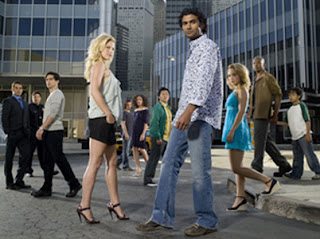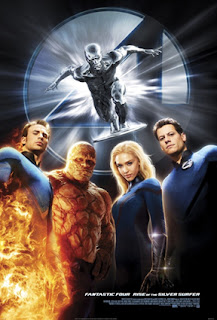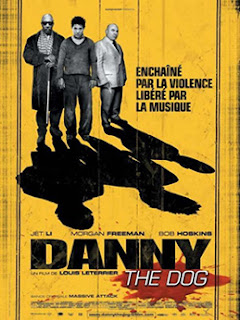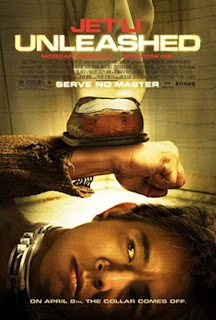+1.jpg)
+3.jpg)
reVIEW (11)
SAW
With Saw IV set to open this Halloween, I thought it a good idea to resurrect this review, which was previously published in 2004 under the title, “The Big Blood-Drenched Picture.”
jigsaw n : a machine saw with a narrow vertically reciprocating blade for cutting curved and irregular lines or ornamental patterns in openwork
vt : to arrange or place in an intricate or interlocking way in the manner of the parts of a jigsaw puzzle
adj : suggesting a jigsaw puzzle or its separate pieces
James Wan’s Saw is the cinematic equivalent of a bear trap (to borrow an analogy from the film); once it begins, those rusty, razor-toothed jaws snap shut, and there’s little else you can do but sit riveted to your seat till the bitter, bloody end.
What if you woke up to find yourself chained to a pipe in a decrepit bathroom, without knowing who put you there, or why?
From this seed, the twisted and gnarled script of Saw—written by Leigh Whannell, who plays Adam in the film—grows.
And it turns out to be one of the best, most intense, and most involving English-language horror films made in quite a while.
An excellent marriage of content and technique, Wan’s directing style, modern and yet not too MTV for its own good, complements the non-linear script written by Whannell to a tight tee. In much the same way that the David Goyer-written script for Alex Proyas’ Dark City emulated the structure of a spiral (a central image of the film), Whannell’s script is a jigsaw puzzle, referring to a central story element of Saw. The plot is structured in such a way that events and revelations are parceled out to us like puzzle pieces, for us to feverishly plant in place, as we attempt to make out the big picture. And, deviously, Whannell and Wan give us pieces that can fit into their slot in more than one way, so our perception of the big picture can change in an instant.
Now, a short lesson: the difference between a plot twist, and a plot flip.
A plot twist is a sudden curveball in the story that you don’t see coming: the apparent good guy who turns out to be a baddie; the seemingly innocuous neighbor who turns out to be a government agent. Plot twists in recent films are (spoilers!!!): exactly who the sacrifice is in Darkness, bringing to light just how wise the titular evil really is, or the fact that there is no Totenkopf in Sky Captain and the World of Tomorrow, merely the video ghost of Sir Lawrence Olivier playing God-in-absentia, as his clockwork creation continues to run through its programmed agenda. There is also the last-second revelation that Beatrix’s child is still alive, at the end of Kill Bill Volume One.
A plot flip is a single event or revelation in the story which results in a total re-evaluation of everything that came before it, a pivot point in the story which requires you to see the whole tale from a different perspective. A very popular plot flip is the ending of The Sixth Sense, which forces you to see the whole film in an entirely different light. There is also Neo’s awakening from The Matrix into the real world (though this occurs early on in the film’s running time), or the pair of flips in Janghwa, Hongryeon (A Tale of Two Sisters).
The wonderful thing about Saw is that it has twists and it has flips. Usually, a film will either have a bunch of twists, or one flip; it’s rare that a film will contain both. (The Village is another recent film that displays its fair share of flips and twists.)
In Saw, the twists and flips are sudden and savage, malevolent Jack in the Boxes that spring out with a demonic howl, leaving in their wake a stunned sense of revelation, as we stand in ever-widening pools of blood, for a few precious moments too shocked to move, lest another come leaping out of the darkness (which it sometimes does).
Now, two films Saw has been compared to since its release are The Blair Witch Project and Se7en, Project merely because of Saw’s low production cost (reportedly less than $10 million), Se7en because of its mood and content.
Se7en seems the more valid of the two comparisons, though I will say this: Saw displays genuine malignancy and unease, as opposed to the faux dress-me-up-in-moody-dimly-lit sequences of MTV malevolence that characterizes Se7en.*
While The Blair Witch Project is the resounding triumph of marketing over content, Se7en is the victory of style over substance.
Saw, for better or worse, is the real thing; it’s the Se7en I wish Se7en had been.
Premiering at the Sundance Film Festival last January to sold-out screenings, Saw is currently enjoying box-office success in the US. Clearly, Saw has hit a nerve, and audiences are twitching and screaming and grimacing, fingers slipping on blood-drenched pieces, as they try desperately to put the puzzle together before the clock runs out.
* Just to be clear: I'm not saying Se7en is a bad film. Not at all.
But I strongly feel that whatever's good about it, is all thanks to David Fincher. What I'm saying is, remove Fincher's style from the equation, and there doesn't seem to be too much in Andrew Kevin Walker's script to differentiate it significantly from any other random religion-obsessed serial killer thriller.
Meanwhile, I feel that there's enough in Whannell's script that, even if it had been helmed by a director less inventive than Wan, that the resultant film would have still been an effective one.
Parting shot: Saw is intense horror, and quite possibly not to everyone’s tastes. A good barometer would be Se7en: if you found that agreeable to your cinematic palette, chances are, you’ll appreciate Saw.
(Saw OS’s courtesy of impawards.com.)
SAW
With Saw IV set to open this Halloween, I thought it a good idea to resurrect this review, which was previously published in 2004 under the title, “The Big Blood-Drenched Picture.”
jigsaw n : a machine saw with a narrow vertically reciprocating blade for cutting curved and irregular lines or ornamental patterns in openwork
vt : to arrange or place in an intricate or interlocking way in the manner of the parts of a jigsaw puzzle
adj : suggesting a jigsaw puzzle or its separate pieces
James Wan’s Saw is the cinematic equivalent of a bear trap (to borrow an analogy from the film); once it begins, those rusty, razor-toothed jaws snap shut, and there’s little else you can do but sit riveted to your seat till the bitter, bloody end.
What if you woke up to find yourself chained to a pipe in a decrepit bathroom, without knowing who put you there, or why?
From this seed, the twisted and gnarled script of Saw—written by Leigh Whannell, who plays Adam in the film—grows.
And it turns out to be one of the best, most intense, and most involving English-language horror films made in quite a while.
An excellent marriage of content and technique, Wan’s directing style, modern and yet not too MTV for its own good, complements the non-linear script written by Whannell to a tight tee. In much the same way that the David Goyer-written script for Alex Proyas’ Dark City emulated the structure of a spiral (a central image of the film), Whannell’s script is a jigsaw puzzle, referring to a central story element of Saw. The plot is structured in such a way that events and revelations are parceled out to us like puzzle pieces, for us to feverishly plant in place, as we attempt to make out the big picture. And, deviously, Whannell and Wan give us pieces that can fit into their slot in more than one way, so our perception of the big picture can change in an instant.
Now, a short lesson: the difference between a plot twist, and a plot flip.
A plot twist is a sudden curveball in the story that you don’t see coming: the apparent good guy who turns out to be a baddie; the seemingly innocuous neighbor who turns out to be a government agent. Plot twists in recent films are (spoilers!!!): exactly who the sacrifice is in Darkness, bringing to light just how wise the titular evil really is, or the fact that there is no Totenkopf in Sky Captain and the World of Tomorrow, merely the video ghost of Sir Lawrence Olivier playing God-in-absentia, as his clockwork creation continues to run through its programmed agenda. There is also the last-second revelation that Beatrix’s child is still alive, at the end of Kill Bill Volume One.
A plot flip is a single event or revelation in the story which results in a total re-evaluation of everything that came before it, a pivot point in the story which requires you to see the whole tale from a different perspective. A very popular plot flip is the ending of The Sixth Sense, which forces you to see the whole film in an entirely different light. There is also Neo’s awakening from The Matrix into the real world (though this occurs early on in the film’s running time), or the pair of flips in Janghwa, Hongryeon (A Tale of Two Sisters).
The wonderful thing about Saw is that it has twists and it has flips. Usually, a film will either have a bunch of twists, or one flip; it’s rare that a film will contain both. (The Village is another recent film that displays its fair share of flips and twists.)
In Saw, the twists and flips are sudden and savage, malevolent Jack in the Boxes that spring out with a demonic howl, leaving in their wake a stunned sense of revelation, as we stand in ever-widening pools of blood, for a few precious moments too shocked to move, lest another come leaping out of the darkness (which it sometimes does).
Now, two films Saw has been compared to since its release are The Blair Witch Project and Se7en, Project merely because of Saw’s low production cost (reportedly less than $10 million), Se7en because of its mood and content.
Se7en seems the more valid of the two comparisons, though I will say this: Saw displays genuine malignancy and unease, as opposed to the faux dress-me-up-in-moody-dimly-lit sequences of MTV malevolence that characterizes Se7en.*
While The Blair Witch Project is the resounding triumph of marketing over content, Se7en is the victory of style over substance.
Saw, for better or worse, is the real thing; it’s the Se7en I wish Se7en had been.
Premiering at the Sundance Film Festival last January to sold-out screenings, Saw is currently enjoying box-office success in the US. Clearly, Saw has hit a nerve, and audiences are twitching and screaming and grimacing, fingers slipping on blood-drenched pieces, as they try desperately to put the puzzle together before the clock runs out.
* Just to be clear: I'm not saying Se7en is a bad film. Not at all.
But I strongly feel that whatever's good about it, is all thanks to David Fincher. What I'm saying is, remove Fincher's style from the equation, and there doesn't seem to be too much in Andrew Kevin Walker's script to differentiate it significantly from any other random religion-obsessed serial killer thriller.
Meanwhile, I feel that there's enough in Whannell's script that, even if it had been helmed by a director less inventive than Wan, that the resultant film would have still been an effective one.
Parting shot: Saw is intense horror, and quite possibly not to everyone’s tastes. A good barometer would be Se7en: if you found that agreeable to your cinematic palette, chances are, you’ll appreciate Saw.
(Saw OS’s courtesy of impawards.com.)

+2+blog.jpg)
.jpg)










+4.jpg)

.jpg)
+1.jpg)
+2.jpg)
+3+blog.jpg)
+blog.jpg)
.jpg)
+2+blog.jpg)
+1+blog.jpg)

.jpg)

+blog.jpg)
+1.jpg)
+2+blog.jpg)
+3+blog.jpg)


+blog.jpg)
+blog.jpg)